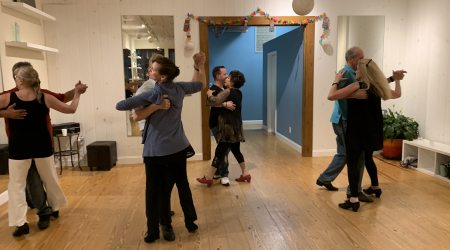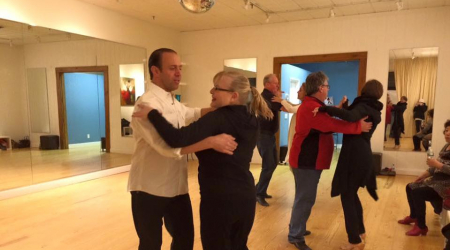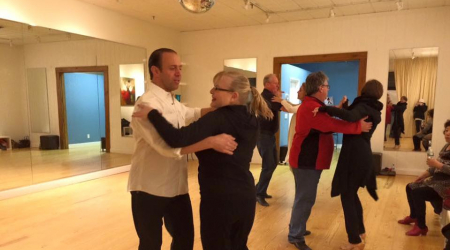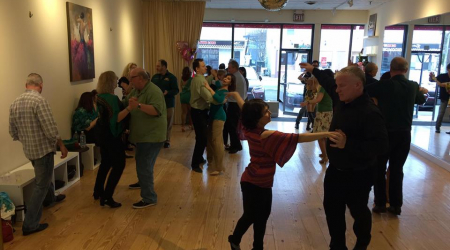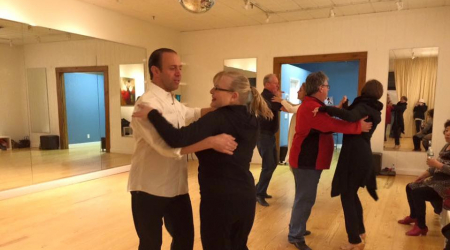History
There are several references to a sliding or gliding dance that would evolve into the waltz that date from 16th century Europe, including the representations of the printmaker Hans Sebald Beham. The French philosopher Montaigne wrote of a dance he saw in 1580 in Augsburg, where the dancers held each other so closely that their faces touched. Kunz Haas (of approximately the same period) wrote, "Now they are dancing the godless Weller or Spinner". "The vigorous peasant dancer, following an instinctive knowledge of the weight of fall, utilises his surplus energy to press all his strength into the proper beat of the bar, thus intensifying his personal enjoyment in dancing".
The peasants of Bavaria, Tyrol, and Styria began dancing a dance called Walzer, a dance for couples, around 1750. The Ländler, also known as the Schleifer, a country dance in 3/4 time, was popular in Bohemia, Austria, and Bavaria, and spread from the countryside to the suburbs of the city. While the eighteenth century upper classes continued to dance the minuet, bored noblemen slipped away to the balls of their servants.
In the 1771 German novel Geschichte des Fräuleins von Sternheim by Sophie von La Roche, a high-minded character complains about the newly introduced waltz among aristocrats thus: "But when he put his arm around her, pressed her to his breast, cavorted with her in the shameless, indecent whirling-dance of the Germans and engaged in a familiarity that broke all the bounds of good breeding—then my silent misery turned into burning rage."
Describing life in Vienna (dated at either 1776 or 1786), Don Curzio wrote, "The people were dancing mad ... The ladies of Vienna are particularly celebrated for their grace and movements of waltzing of which they never tire." There is a waltz in the second act finale of the opera "Una Cosa Rara" written by Martin y Soler in 1786. Soler's waltz was marked Andante con moto, or "at a walking pace with motion", but the flow of the dance was sped-up in Vienna leading to the Geschwindwalzer, and the Galloppwalzer.
In the transition from country to town, the hopping of the Ländler, a dance known as Langaus, became a sliding step, and gliding rotation replaced stamping rotation.
In the 19th century, the word primarily indicated that the dance was a turning one; one would "waltz" in the polka to indicate rotating rather than going straight forward without turning.
The Viennese custom is to slightly anticipate the second beat of each bar, making it sound as if the third is late and creating a certain buoyancy. The younger Strauss (Johann Strauss II) would sometimes break up the one-two-three of the melody with a one-two pattern in the accompaniment along with other rhythms, maintaining the 3/4 time while causing the dancers to dance a two-step waltz. The metronome speed for a full bar varies between 60 and 70, with the waltzes of the first Strauss (Johann Strauss I) often played faster than those of his sons.
Shocking many when it was first introduced, the waltz became fashionable in Vienna around the 1780s, spreading to many other countries in the years to follow. According to contemporary singer Michael Kelly, it reached England in 1791. During the Napoleonic Wars, infantry soldiers of the King's German Legion introduced the dance to the people of Bexhill, Sussex from 1804.
It became fashionable in Britain during the Regency period, having been made respectable by the endorsement of Dorothea Lieven, wife of the Russian ambassador. Diarist Thomas Raikes later recounted that "No event ever produced so great a sensation in English society as the introduction of the waltz in 1813". In the same year, a sardonic tribute to the dance by Lord Byron was anonymously published (written the previous autumn). Influential dance master and author of instruction manuals, Thomas Wilson published A Description of the Correct Method of Waltzing in 1816. Almack's, the most exclusive club in London, permitted the waltz though the entry in the Oxford English Dictionary shows that it was considered "riotous and indecent" as late as 1825. Ann Bronte in 'The Tenant of Wildfell Hall' has a scene set in 1827 where the local vicar Reverend Milward tolerates quadrilles and country dances but intervenes decisively when a waltz is called for, declaring "No, no, I don't allow that! Come, it's time to be going home".
The waltz, and especially its closed position, became the example for the creation of many other ballroom dances. Subsequently, new types of waltz have developed, including many folk and several ballroom dances.
Source: Wikipedia
